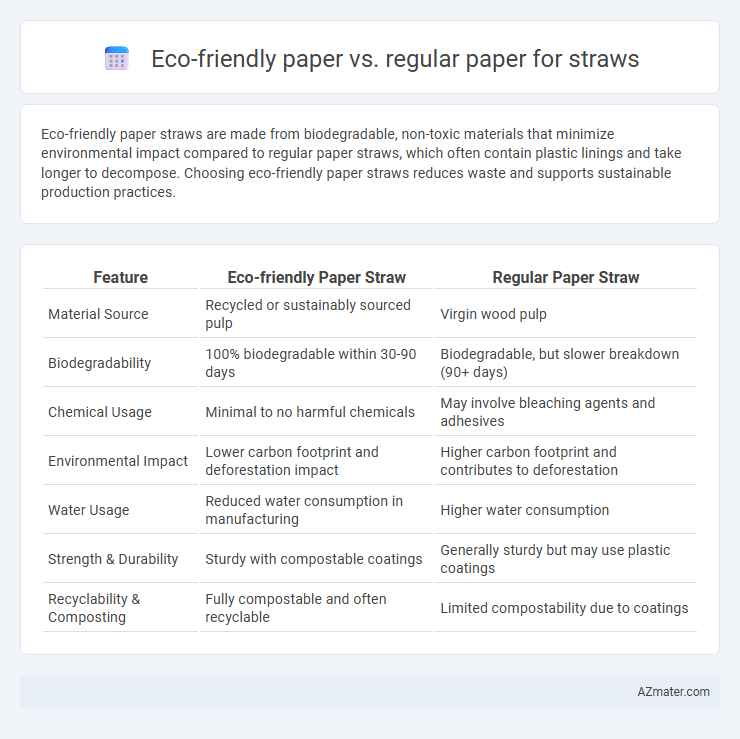Eco-friendly paper straws are made from biodegradable, non-toxic materials that minimize environmental impact compared to regular paper straws, which often contain plastic linings and take longer to decompose. Choosing eco-friendly paper straws reduces waste and supports sustainable production practices.
Table of Comparison
| Feature | Eco-friendly Paper Straw | Regular Paper Straw |
|---|---|---|
| Material Source | Recycled or sustainably sourced pulp | Virgin wood pulp |
| Biodegradability | 100% biodegradable within 30-90 days | Biodegradable, but slower breakdown (90+ days) |
| Chemical Usage | Minimal to no harmful chemicals | May involve bleaching agents and adhesives |
| Environmental Impact | Lower carbon footprint and deforestation impact | Higher carbon footprint and contributes to deforestation |
| Water Usage | Reduced water consumption in manufacturing | Higher water consumption |
| Strength & Durability | Sturdy with compostable coatings | Generally sturdy but may use plastic coatings |
| Recyclability & Composting | Fully compostable and often recyclable | Limited compostability due to coatings |
Introduction: The Rise of Paper Straws
The rise of paper straws reflects a growing shift towards sustainable alternatives to plastic in the beverage industry. Eco-friendly paper straws are typically made from biodegradable materials and use non-toxic adhesives, reducing environmental impact compared to regular paper straws that often contain plastic linings or less sustainable pulp sources. Increasing consumer demand and regulatory bans on single-use plastics drive the adoption of eco-friendly paper straws in cafes, restaurants, and events worldwide.
What is Eco-Friendly Paper?
Eco-friendly paper is produced using sustainable methods that minimize environmental impact, often incorporating recycled fibers, chlorine-free bleaching, and non-toxic inks. It reduces deforestation, water consumption, and carbon emissions compared to regular paper made from virgin wood pulp. This eco-conscious approach makes eco-friendly paper a preferred choice for straws, promoting biodegradability and reducing plastic pollution.
Composition of Regular Paper Straws
Regular paper straws are typically composed of wood pulp fibers combined with synthetic additives such as plastic coatings or glues to enhance durability and moisture resistance. These coatings often contain polyethylene or other non-biodegradable materials that hinder full compostability and increase environmental impact. In contrast, eco-friendly paper straws utilize unbleached, chlorine-free fibers and biodegradable adhesives, ensuring better sustainability without compromising strength and usability.
Environmental Impact: Eco-Friendly Paper vs Regular Paper
Eco-friendly paper straws, made from sustainable sources and biodegradable materials, significantly reduce plastic pollution and landfill waste compared to regular paper straws, which often contain chemical coatings that hinder decomposition. The production of eco-friendly paper involves lower energy consumption and fewer harmful emissions, aligning with global efforts to minimize carbon footprints and preserve natural resources. Choosing eco-friendly paper over regular paper supports circular economy principles by promoting compostability and reducing environmental harm during both manufacturing and disposal stages.
Manufacturing Process and Sustainability
Eco-friendly paper straws are manufactured using renewable raw materials, often from sustainably sourced fibers and without harmful bleaches or chemicals, reducing environmental impact compared to regular paper straws made from conventional wood pulp treated with synthetic additives. The manufacturing process for eco-friendly paper prioritizes water and energy efficiency, producing less pollution and enabling safer biodegradability and compostability. Sustainable practices in eco-friendly paper straw production contribute significantly to lowering carbon footprints and minimizing landfill waste, supporting circular economy goals.
Biodegradability and Composting Benefits
Eco-friendly paper used for straws is typically made from natural fibers, making it highly biodegradable and capable of decomposing within weeks in composting environments. Unlike regular paper straws treated with chemicals or coatings, eco-friendly variants break down more easily, reducing landfill waste and environmental pollution. Composting eco-friendly paper straws enriches soil with organic matter, promoting sustainable waste management and minimizing carbon footprint.
Durability and Performance Comparison
Eco-friendly paper straws made from recycled fibers or plant-based materials exhibit comparable durability to regular paper straws but offer enhanced biodegradability and reduced environmental impact. Regular paper straws often rely on virgin wood pulp, which provides consistent performance but contributes to deforestation and slower decomposition rates. Performance evaluations indicate that eco-friendly paper straws maintain structural integrity during typical beverage use while minimizing waste and promoting sustainable resource management.
Cost Analysis and Market Trends
Eco-friendly paper straws typically cost 15-30% more than regular paper straws due to sustainable sourcing and biodegradable materials, impacting short-term procurement budgets. Market trends reveal a growing consumer preference for eco-friendly straws, driving increased demand and investment in sustainable packaging solutions across foodservice industries. Economies of scale and technological advancements are gradually narrowing the cost gap, making eco-friendly paper straws more competitive in price compared to conventional options.
Consumer Preferences and Perceptions
Consumers increasingly prefer eco-friendly paper straws due to growing environmental awareness and concerns about plastic pollution. Studies show that biodegradable and compostable paper straws are perceived as healthier and more sustainable compared to regular paper straws, which often use non-recycled fibers and chemical coatings. Market research indicates that a majority of buyers are willing to pay a premium for straws made from recycled or sustainably sourced paper, emphasizing demand for transparent sourcing and environmental certifications.
Future of Sustainable Straw Solutions
Eco-friendly paper straws made from biodegradable materials significantly reduce plastic waste and pollution compared to regular paper straws, which often contain synthetic coatings that hinder compostability. Innovations in sustainable straw solutions prioritize plant-based fibers and water-resistant natural coatings to enhance durability while ensuring complete biodegradability. Future developments aim to balance usability with environmental impact, promoting widespread adoption driven by regulatory pressures and increasing consumer demand for zero-waste alternatives.

Infographic: Eco-friendly paper vs Regular paper for Straw
 azmater.com
azmater.com